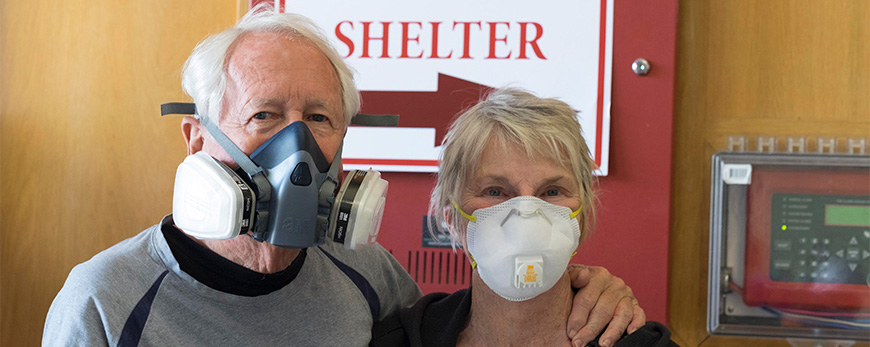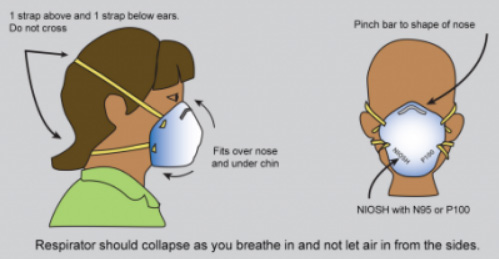
Wildfires create smoky conditions, but there are things you can do– indoors and out–to reduce your exposure to smoke. Children (498 KB), older adults, and people with heart or lung disease are particularly susceptible to the health impacts of wildfire smoke, but it can also pose risks to healthy adults.
Reduce Smoke Exposure Outdoors

If it’s smoky outdoors, it’s best to limit the amount of time you spend outside. Soot and fine particulates can cause coughing, wheezing, itchy eyes, runny nose, scratchy throat, and difficulty breathing.
- Reduce your physical activity outdoors.
- Know your air quality. Smoke levels can change a lot during the day, so wait until air quality is better before you are active outdoors. Visit air.utah.gov or download the free UtahAir app for iPhone and Android for air-quality forecasts and current air-quality conditions.
- Have enough food and medication on hand to last several days, so you don’t have to go out for supplies. If you must go out, avoid the smokiest times of the day.
- Reduce smoke in your vehicle by closing the windows and vents and running the air conditioner in recirculate mode.
- Do not rely on dust masks from the hardware store or bandanas for protection from smoke. If you must be out in smoky conditions, an N95 respirator can protect you if it fits snugly to your face and is worn properly.
- Have a plan to evacuate. Know how you will get alerts and health warnings, including air-quality reports and public service announcements (PSAs). Public advisories can provide important information such as changing smoke conditions and evacuation notices. Know your evacuation routes, organize your important items ahead of time, and know where to go in case you have to evacuate.
Reduce Smoke Exposure Indoors
Particulate levels can still be high indoors if the fire is close, but they are still lower inside than outside. If there is an active fire in your area and it is very close to your house, it may be best to evacuate. Fires can spread quickly and the smoke plume can make it difficult to see in an evacuation. In addition, it can be nearly impossible to keep dense smoke from building up in the indoor air. Pay close attention to local emergency alerts to know when to evacuate. Outdoor air, including fine particles from wildfire smoke, can enter your home through open windows and doors, through bathroom or kitchen fans that vent to the outdoors, heating and air conditioning systems with a fresh air intake, and through small openings, joints, cracks, and around closed windows.
- Avoid using anything that burns, such as wood fireplaces, gas logs, gas stoves, or even candles.
- Don’t vacuum, since it stirs up particles already inside homes.
- Don’t smoke.
- Follow the directions of their doctor regarding medication and asthma management plan. Call your doctor if symptoms worsen.
- Talk with their personal physician about whether and when you should leave the area. When smoke is heavy for a prolonged period of time, fine particles can build up indoors even though they are not visible.
Prepare for Possible Evacuation
If there is an active fire in your area and it is very close to your house, it may be best to evacuate. Fires can spread quickly and the smoke plume can make it difficult to see in an evacuation. In addition, it can be nearly impossible to keep dense smoke from building up in the indoor air. Pay close attention to local emergency alerts to know when to evacuate. Leaving the area may be best for those with health conditions that put them at higher risk for illness.
If a wildfire is close enough to cause high smoke levels, but the fire is not threatening your home, smoke may enter your home and make it harder to breathe. Learn more about what to do in this situation and how to prepare for it. If you don’t have an air-conditioning system in your house, go to a local public building with air conditioning such as a movie theater, mall or library. Seek a local clean air shelter or stay at a friend or relative’s home away from smoke.
You may hear that smoke from a far-away wildfire has spread to your community, even if it is thousands of miles away. While this can happen, the amount of smoke that may reach your community from such a distance is probably very small and may be overshadowed by local sources of particle pollution.

Some evacuation centers do not accept animals. Check Petfinder’s Shelter Center or RedRover for information on local animal shelters and rescue groups.
